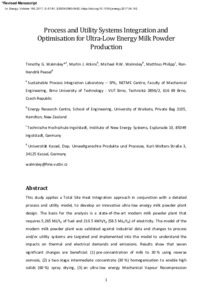Process and utility systems integration and optimisation for ultra-low energy milk powder production
| dc.date.accessioned | 2021-03-10T13:43:07Z | |
| dc.date.available | 2021-03-10T13:43:07Z | |
| dc.date.issued | 2017-04-26 | |
| dc.identifier | doi:10.17170/kobra-202103093470 | |
| dc.identifier.uri | http://hdl.handle.net/123456789/12605 | |
| dc.description | This is a revised manuscript of the article "Process and utility systems integration and optimisation for ultra-low energy milk powder production". The final authenticated version is available online at: https://doi.org/10.1016/j.energy.2017.04.142 | ger |
| dc.language.iso | eng | eng |
| dc.rights | Attribution-NonCommercial-NoDerivatives 4.0 International | * |
| dc.rights.uri | http://creativecommons.org/licenses/by-nc-nd/4.0/ | * |
| dc.subject | process integration | eng |
| dc.subject | milk powder | eng |
| dc.subject | total site | eng |
| dc.subject | process modelling | eng |
| dc.subject.ddc | 333 | |
| dc.subject.ddc | 670 | |
| dc.title | Process and utility systems integration and optimisation for ultra-low energy milk powder production | eng |
| dc.type | Aufsatz | |
| dcterms.abstract | This study applies a Total Site Heat Integration approach in conjunction with a detailed process and utility model, to develop an innovative ultra-low energy milk powder plant design. The basis for the analysis is a state-of-the-art modern milk powder plant that requires 5265 MJ/tp of fuel and 210.5 kWh/tp (58.5 MJe/tp) of electricity. The model of the modern milk powder plant was validated against industrial data and changes to process and/or utility systems are targeted and implemented into the model to understand the impacts on thermal and electrical demands and emissions. Results show that seven significant changes are beneficial: (1) pre-concentration of milk to 30% using reverse osmosis, (2) a two-stage intermediate concentrate (30%) homogenisation to enable high solids (60%) spray drying, (3) an ultra-low energy Mechanical Vapour Recompression evaporator system, (4) spray dryer exhaust heat recovery, (5) condensing economiser for the boiler, (6) upgrade and integration of chiller condenser heat with hot water utility systems, and (7) recycling of air in the building ventilation system. These changes are estimated to reduce thermal energy use by 51.5%, electricity use by 19.0%, and emissions by 48.6% compared to a modern milk powder plant. | eng |
| dcterms.accessRights | open access | |
| dcterms.creator | Walmsley, Timothy Gordon | |
| dcterms.creator | Atkins, Martin John | |
| dcterms.creator | Walmsley, Michael R. W. | |
| dcterms.creator | Philipp, Matthias | |
| dcterms.creator | Peesel, Ron-Hendrik | |
| dc.relation.doi | doi:10.1016/j.energy.2017.04.142 | |
| dc.subject.swd | Trockenmilch | ger |
| dc.subject.swd | Produktionsorganisation | ger |
| dc.subject.swd | Prozessmanagement | ger |
| dc.subject.swd | Prozessmodell | ger |
| dc.subject.swd | Wärme | ger |
| dc.subject.swd | Energieeffizienz | ger |
| dc.type.version | acceptedVersion | |
| dcterms.source.identifier | EISSN 0360-5442 | |
| dcterms.source.journal | Energy | eng |
| dcterms.source.pageinfo | 67-81 | |
| dcterms.source.volume | Volume 146 | |
| kup.iskup | false |
Files in this item
This item appears in the following Collection(s)
-
Publikationen [18]


